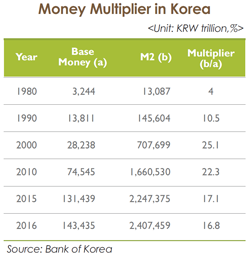
This March, the Federal Open
Market Committee (FOMC)
made a bold turnaround move
by raising the federal funds rate
by 0.25 percent—from 0.50-0.75 percent
to 0.75-1 percent. This rate hike signifies
that the FOMC is departing from the
decade-old tradition of low rates, instead
opting for more “normal” rates. No one
knows what exactly what the normal rates
are, but everybody knows for certain that
the current rate is too low. No matter who
has initiated it, and no matter how successful
it has been in dealing with the
post subprime mortgage crisis, this
decade-long low rate regime should come
to an end and give way to a new world
where normal rates preside.
The normalization policy of returning
to a higher rate is hard to understand for
most people, especially when the economy
has been sluggish for quite some time
and a majority of people are ridden with
heavy debt. Despite the assurances of the
U.S. Federal Reserve about strong
employment and inflation statistics, many
people believe the U.S. economy is still
far from full employment, and a higher
rate is hard to accept. For countries like
Korea, such a rate might be even more
difficult to swallow.
But like always, there is the other side
of the coin. A higher rate could actually
be a blessing, helping the economy come
out of a long economic slump. First, this
rate policy allows higher income to
depositors. Under a high rate regime,
commercial banks naturally have to ask
for higher rates to the borrowers, but at
the same time, they should provide higher
rates to depositors in order to attract new
deposits. Thus, a higher deposit rate
makes it possible for depositors to have a
higher income. In Korea, aggregate deposits of the banking industry amounts
to almost KRW 2.3 quadrillion, and a 1
percent increase
in the deposit rate means
KRW 23 trillion extra interest income to
depositors, which equals about 3 percent
of KRW 770 trillion in private consumption.
Therefore, an increase in the deposit interest rate could work as a strong stimulant
for private consumption.
Second, a higher rate would enable
banks to create more credit to the system
by encouraging more deposits to the
banking system. In other words, a higher
rate could encourage money supply by
the credit creation process. It may seem
odd, but past history has proved that this
is effective. The low rate regime in the
past discouraged bank savings, substantially
reducing the growth of money supply.
One of the critical consequences was
a secular fall of the money multiplier.
The money multiplier, which is defined
as the ratio of broad money (M2) over
base money, is a barometer of banking
activities—the higher the multiplier, the
more active the banking industry. As the
table below shows, the money multiplier
in Korea has surged from 4 in 1980 to 25
in 2000, but it dropped to 16 in 2016.
Third, it would also encourage financial
industries, such as the banking and
insurance industries, by making the net
interest margin (NIM) a lot higher.
Indeed, low rates from 2008 until recently
have made the profitability of banking
and insurance industries extremely low
because the NIM was chronically dipping.
Now, however, the banking and
insurance industries expect better profitability,
and this could be a driving force
of new economic growth in the financial
industries.
Fourth, a higher rate would make
financial industries more balanced by
channeling funds from stock markets to
other fields such as bonds, direct investments
and various funds. So far under an
extremely low rate

environment, global stock markets have been overheated while other financial industries are suffering relative impasse. The unbalanced development of financial markets with overheating stock markets amid a bleak banking industry and bond markets should arouse serious concern for regulators. All these imbalances were believed to be the outcome of abnormally low rates in the past. Now, the Bank of Korea and the Financial Services Commission have to make a very difficult decision on the interest rate policy. Despite economic uncertainty, it would be more optimal for the government to forgo its policy of leaning against the wind. That is, it can’t let the rate fix stay the way it is for an indefinite amount of time. A better solution would be to lean with the wind and let the markets dictate where the interest rates and exchange rates should go. The government should not excessively intervene in their course. Otherwise, they have to face bigger challenges ahead.